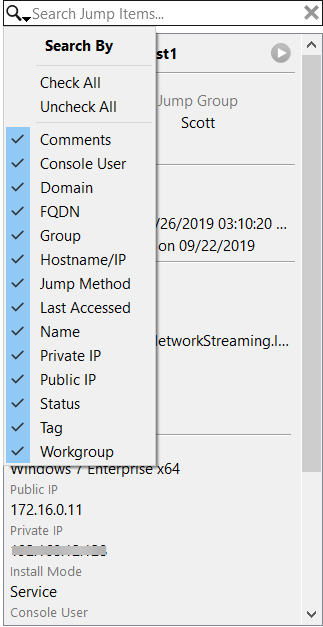
To change the fields you are searching, click the magnifying glass and check or uncheck any of the available fields. Enter a string in the search field and then press Enter. In addition to browsing for Jump Clients, you can search based on multiple fields. Click the arrow to show or hide the tags.

If a Jump Group contains tagged Jump Clients, an arrow appears to the left of the Jump Group name. If you are allowed to view Jump Clients in other users' personal lists of Jump Items, those users appear in a second pane to the left. Additionally, you might have permission to access Jump Items in Jump Groups you do not belong to and personal Jump Items for non-team members. Similarly, if you are a team manager or lead with appropriate permissions, you might see team members' personal lists of Jump Items. Your personal list of Jump Items is primarily for your individual use, although your team leads, team managers, and users with permission to see all Jump Items might have access to your personal list of Jump Items. If you are assigned to one or more Jump Groups, you can access the Jump Items in those groups, with the permissions assigned by your admin. Collectively, Jump Clients and Jump shortcuts are referred to as Jump Items.įrom the left pane, select the Jump Group for which you want to view pinned Jump Clients.

In addition to Jump Clients, you may also see Jump shortcuts for remote Jumps, local Jumps, VNC sessions, RDP sessions, and Shell Jumps. Jump Clients are listed in the Jump Interface. Once a Jump Client has been installed on a remote computer, permitted users can use the Jump Client to initiate a session with that computer, even if the computer is unattended. Start a Support Session through a Jump Client


 0 kommentar(er)
0 kommentar(er)
